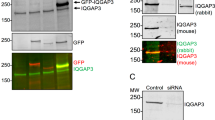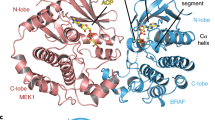Abstract
The mutant of Ras protein with serine to asparagine mutation at residue 17 (Ras–17N) is known to interfere with the signaling function of the wild-type Ras protein by sequestering its guanine-nucleotide exchange factors (GEFs). The similar mutant of another Ras family protein Rap1 (Rap1–17N) fails to effectively interfere with the interaction between the wild-type Rap1 and one of its GEFs, C3G, in vitro. In the present study, we have attempted to isolate Rap1 mutants with increased affinity for C3G using random mutagenesis and yeast two-hybrid screening. Based on the pattern of mutations found among these mutants, we could design a potent C3G-binder, named Rap1-AGE, harboring mutations in three sites (17A, 29G, and 117E). The association of Rap1-AGE with C3G in the cells was confirmed by co-immunoprecipitation experiments. The ability of Rap1-AGE to inhibit C3G-mediated Rap1-activation and cell spreading was also demonstrated. On the other hand, Rap1 activation mediated by two other GEFs, Epac and smgGDS, was not inhibited by Rap1-AGE. These results suggest that Rap1-AGE acts as a dominant interfering factor against C3G and serves as a useful tool in analyzing the roles of C3G-Rap1 signaling pathway in various biological processes.
This is a preview of subscription content, access via your institution
Access options
Subscribe to this journal
Receive 50 print issues and online access
$259.00 per year
only $5.18 per issue
Buy this article
- Purchase on Springer Link
- Instant access to full article PDF
Prices may be subject to local taxes which are calculated during checkout







Similar content being viewed by others
References
Beranger F, Goud B, Tavitian A and de Gunzburg J . (1991). Proc. Natl. Acad. Sci. USA, 88, 1606–1610.
Bos JL, de Rooij J and Reedquist KA . (2001). Nat. Rev. Mol. Cell. Biol., 2, 369–377.
Caron E, Self AJ and Hall A . (2000). Curr. Biol., 10, 974–978.
Chen SY, Huff SY, Lai CC, Der CJ and Powers S . (1994). Oncogene, 9, 2691–2698.
Cook SJ, Rubinfeld B, Albert I and McCormick F . (1993). EMBO J., 12, 3475–3485.
de Rooij J, Boenink NM, van Triest M, Cool RH, Wittinghofer A and Bos JL . (1999). J. Biol. Chem., 274, 38125–38130.
de Rooij J, Zwartkruis FJ, Verheijen MH, Cool RH, Nijman SM, Wittinghofer A and Bos JL . (1998). Nature, 396, 474–477.
Feig LA . (1999). Nat. Cell Biol., 1, E25–E27.
Feig LA and Cooper GM . (1988). Mol. Cell. Biol., 8, 3235–3243.
Feller SM . (2001). Oncogene, 20, 6348–6371.
Franke B, Akkerman JW and Bos JL . (1997). EMBO J., 16, 252–259.
Furth ME, Davis LJ, Fleurdelys B and Scolnick EM . (1982). J. Virol., 43, 294–304.
Gotoh T, Hattori S, Nakamura S, Kitayama H, Noda M, Takai Y, Kaibuchi K, Matsui H, Hatase O, Takahashi H, Kurata T and Matsuda M . (1995). Mol. Cell. Biol., 15, 6746–6753.
Herskowitz I . (1987). Nature, 329, 219–222.
Imamura Y, Matsumoto N, Kondo S, Kitayama H and Noda M . (2003). Neuroreport, 14, 1203–1207.
Imamura Y, Matsumoto N, Kondo S, Kitayama H and Noda M . (2004). Neuroscience, 127, 973–981.
Katagiri K, Hattori M, Minato N, Irie S, Takatsu K and Kinashi T . (2000). Mol. Cell. Biol., 20, 1956–1969.
Katagiri K, Maeda A, Shimonaka M and Kinashi T . (2003). Nat. Immunol., 4, 741–748.
Kawasaki H, Springett GM, Toki S, Canales JJ, Harlan P, Blumenstiel JP, Chen EJ, Bany IA, Mochizuki N, Ashbacher A, Matsuda M, Housman DE and Graybiel AM . (1998). Proc. Natl. Acad. Sci. USA, 95, 13278–13283.
Kinbara K, Goldfinger LE, Hansen M, Chou FL and Ginsberg MH . (2003). Nat. Rev. Mol. Cell. Biol., 4, 767–776.
Kitayama H, Matsuzaki T, Ikawa Y and Noda M . (1990). Proc. Natl. Acad. Sci. USA, 87, 4284–4288.
Kitayama H, Sugimoto Y, Matsuzaki T, Ikawa Y and Noda M . (1989). Cell, 56, 77–84.
Milburn MV, Tong L, deVos AM, Brunger A, Yamaizumi Z, Nishimura S and Kim SH . (1990). Science, 247, 939–945.
Mochizuki N, Ohba Y, Kiyokawa E, Kurata T, Murakami T, Ozaki T, Kitabatake A, Nagashima K and Matsuda M . (1999). Nature, 400, 891–894.
Mochizuki N, Yamashita S, Kurokawa K, Ohba Y, Nagai T, Miyawaki A and Matsuda M . (2001). Nature, 411, 1065–1068.
Noda M . (1993). Biochim. Biophys. Acta, 1155, 97–109.
Ohba Y, Ikuta K, Ogura A, Matsuda J, Mochizuki N, Nagashima K, Kurokawa K, Mayer BJ, Maki K, Miyazaki J and Matsuda M . (2001). EMBO J., 20, 3333–3341.
Ohba Y, Mochizuki N, Yamashita S, Chan AM, Schrader JW, Hattori S, Nagashima K and Matsuda M . (2000). J. Biol. Chem., 275, 20020–20026.
Pak DT, Yang S, Rudolph-Correia S, Kim E and Sheng M . (2001). Neuron, 31, 289–303.
Reedquist KA, Ross E, Koop EA, Wolthuis RM, Zwartkruis FJ, van Kooyk Y, Salmon M, Buckley CD and Bos JL . (2000). J. Cell Biol., 148, 1151–1158.
Rubinfeld B, Munemitsu S, Clark R, Conroy L, Watt K, Crosier WJ, McCormick F and Polakis P . (1991). Cell, 65, 1033–1042.
Schmitt JM and Stork PJ . (2000). J. Biol. Chem., 275, 25342–25350.
Serebriiskii I, Estojak J, Sonoda G, Testa JR and Golemis EA . (1997). Oncogene, 15, 1043–1049.
Song C, Hu CD, Masago M, Kariyai K, Yamawaki-Kataoka Y, Shibatohge M, Wu D, Satoh T and Kataoka T . (2001). J. Biol. Chem., 276, 2752–2757.
Sprang SR . (1997). Annu. Rev. Biochem., 66, 639–678.
Stork PJ . (2003). Trends. Biochem. Sci., 28, 267–275.
Tanaka S, Morishita T, Hashimoto Y, Hattori S, Nakamura S, Shibuya M, Matuoka K, Takenawa T, Kurata T, Nagashima K and Matsuda M . (1994). Proc. Natl. Acad. Sci. USA, 91, 3443–3447.
Tsukamoto N, Hattori M, Yang H, Bos JL and Minato N . (1999). J. Biol. Chem., 274, 18463–18469.
Tsygankova OM, Saavedra A, Rebhun JF, Quilliam LA and Meinkoth JL . (2001). Mol. Cell. Biol., 21, 1921–1929.
van den Berghe N, Cool RH, Horn G and Wittinghofer A . (1997). Oncogene, 15, 845–850.
van den Berghe N, Cool RH and Wittinghofer A . (1999). J. Biol. Chem., 274, 11078–11085.
Vetter IR and Wittinghofer A . (2001). Science, 294, 1299–1304.
Voss AK, Gruss P and Thomas T . (2003). Development, 130, 355–367.
Vossler MR, Yao H, York RD, Pan MG, Rim CS and Stork PJ . (1997). Cell, 89, 73–82.
Yamamoto T, Kaibuchi K, Mizuno T, Hiroyoshi M, Shirataki H and Takai Y . (1990). J. Biol. Chem., 265, 16626–16634.
York RD, Yao H, Dillon T, Ellig CL, Eckert SP, McCleskey EW and Stork PJ . (1998). Nature, 392, 622–626.
Zhu JJ, Qin Y, Zhao M, Van Aelst L and Malinow R . (2002). Cell, 110, 443–455.
Zwartkruis FJ, Wolthuis RM, Nabben NM, Franke B and Bos JL . (1998). EMBO J., 17, 5905–5912.
Acknowledgements
We thank Jiegou Xu and Kazumi Nobumoto for discussions, Dr Shinae Kondoh and Shunya Kondo for technical advice, Emi Nishimoto for technical assistance, and Aki Miyazaki for secretarial assistance. We are also grateful to Dr Yoji Ikawa for the continued encouragement. This work was supported by grants from the Ministry of Education, Culture, Sports, Science, and Technology of Japan.
Author information
Authors and Affiliations
Corresponding author
Rights and permissions
About this article
Cite this article
Shi, S., Noda, M. & Kitayama, H. Rap1 mutants with increased affinity for the guanine-nucleotide exchange factor C3G. Oncogene 23, 8711–8719 (2004). https://doi.org/10.1038/sj.onc.1208132
Received:
Revised:
Accepted:
Published:
Issue Date:
DOI: https://doi.org/10.1038/sj.onc.1208132



